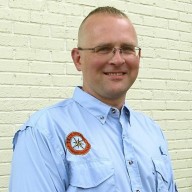Preparation is Key
Whether it is preparing for an unexpected survival or medical emergency, a common misconception exists. That is, that one can effectively deal with the emergency with only the barest minimum of equipment. For example, some people believe that they should be able to survive if they were suddenly blindfolded and dropped into the wilderness, in winter, dressed only in their underwear and equipped simply with a knife (Don’t laugh, I have actually heard this). Perhaps this might work on a television reality show, but I doubt that it would work in actual reality. This misconception can potentially be deadly.
Consider the heroic rescue reported by The Salem News this weekend in Peabody, Massachusetts:
 A snowplow driver, who was parked in the break-down lane of Interstate 95 on Friday, watched a Jeep Wrangler slam, at roughly 60 miles per hour, into the back of a front-end loader being operated by a co-worker. The operator, who was unharmed, and the driver then ran to help the victim. As the two men struggled to release the seat belt with their hands, the Wrangler burst into flame. Finally, they freed the victim. Just as they were dragging him from his vehicle … with his pants on fire … the Wrangler exploded. Other than some broken bones, the victim was in otherwise good condition, and the rescuers were unharmed. The one rescuer commented afterwards about the difficulty of releasing the seat belt, “I never felt so useless in my life … When that seat belt released, I felt like I hit Megabucks.” This experience convinced him to now always carry a knife.
A snowplow driver, who was parked in the break-down lane of Interstate 95 on Friday, watched a Jeep Wrangler slam, at roughly 60 miles per hour, into the back of a front-end loader being operated by a co-worker. The operator, who was unharmed, and the driver then ran to help the victim. As the two men struggled to release the seat belt with their hands, the Wrangler burst into flame. Finally, they freed the victim. Just as they were dragging him from his vehicle … with his pants on fire … the Wrangler exploded. Other than some broken bones, the victim was in otherwise good condition, and the rescuers were unharmed. The one rescuer commented afterwards about the difficulty of releasing the seat belt, “I never felt so useless in my life … When that seat belt released, I felt like I hit Megabucks.” This experience convinced him to now always carry a knife.
So, what is a good lesson to take away from this story? I would argue that a little preparation goes a huge way. After all, in this situation, all three men came extremely close to dying. Horribly.
Yes, one can always improvise in an emergency situation. In fact, whether it is a wilderness survival course, or a Wilderness First Aid certification class, I repeatedly stress the importance and power of improvisation.
However, at True North Outdoor School, we teach that the foundation of either survival or wilderness medicine training is being prepared. Even just having a few tools or pieces of material can be empowering. Maybe even life saving. For example, one should always be prepared to start a fire in 5 minutes in all types of weather conditions. Starting a fire through “primitive” means, like with a bow and drill, is a wonderfully important skill to master, but, trust me, when your patient is hypothermic (and maybe you too), you will be extremely stressed and unhappy as you spend the quite possibly 1+ hours needed to find the materials and prepare them, before you can even start trying to generate an ember.
Luckily, the rescuers were able to finally release the seat belt, because if they had to take the time to improvise a cutting tool, the victim would now be a charred roadway statistic.
So the next time you head out on the trail for a day-hike, take with you even just a few basic items such as a knife, a whistle, extra clothing, and a fire-starting device (either a flint-and-steel type and/or a good lighter).
Because who wants to be found in deep in the woods as a frozen block dressed in their skivvies? Not me!
—————————-
Would you like to learn more about wilderness survival and how to be better prepared for an emergency? Then join Erik at REI Settlers Ridge where he will be giving an upcoming lecture on this subject. Check out the details here.

